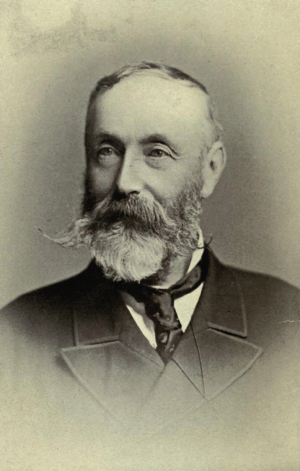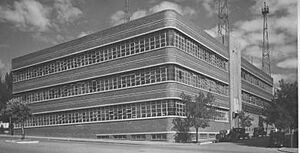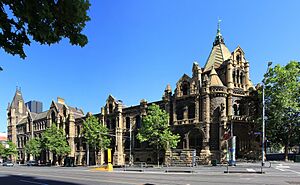History of the Royal Melbourne Institute of Technology facts for kids
The Royal Melbourne Institute of Technology (RMIT) is a public university in Melbourne, Victoria, Australia. It was founded in 1887 by Francis Ormond.
Contents
How RMIT Started

In 1881, a kind and wealthy man named Francis Ormond suggested building a special college. He thought a "technical college" would help people in Melbourne learn useful skills. Ormond had already given a lot of money to start Ormond College at the University of Melbourne. He offered £5,000 for this new college if the public also raised the same amount.
The Melbourne Trades Hall helped gather money from its union members. Building the "Working Men's College" began in 1886. It was built on land given by the Colony of Victoria. The college was next to the Melbourne Magistrates' Court and the State Library of Victoria on La Trobe Street.
The College officially opened on June 4, 1887. On its first night, 320 students signed up. This number grew to over 1000 in the first year! Francis Ormond strongly believed in education. He worked hard for the College and was its President until he passed away in 1889.
The College started offering full-time courses in 1899. It became a private college in 1904. Around this time, it began teaching subjects like engineering, applied science, chemistry, metallurgy, and mining. Between the 1900s and 1920s, the College grew. It built two new buildings on Bowen Street, an Art School, and even bought the nearby Old Melbourne Gaol site for more space.
In the 1930s, the College expanded further. It completed an Engineering School and a Radio School. Two more buildings were built on Bowen Street. In 1934, the College changed its name to the "Melbourne Technical College." This name included "The Working Men's College."
A Mystery at the Old Gaol Site
After the nearby Old Melbourne Gaol closed and was partly pulled down in the 1920s, the College bought the land. In 1929, during the building of the Kernot Engineering School, some human remains were found. People thought these might be the remains of Ned Kelly, a famous Australian bushranger.
These remains were later reburied at Pentridge Prison and found again in 2008. However, there is no clear proof that they belonged to Ned Kelly. Many historians believe his remains are still buried under the current RMIT buildings.
Helping During World Wars
The College helped Australia during World War I and World War II. From 1917 to 1919, it trained over 1500 soldiers who returned from World War I. They learned skills for life after the war.
Between 1939 and 1945, during World War II, the College helped even more. It trained 23,000 service members, including many Royal Australian Air Force personnel. They learned radio communications. The College also trained 2,000 civilians to make war supplies. The Australian government even asked the College to make parts for the Air Force's DAP Beaufort Bomber planes.
After World War II, in the 1950s, the College again trained service members for civilian life. This led to new courses in food technology, transport studies, accountancy, and advertising. The College also welcomed many students from South East Asia through the Colombo Plan.
Becoming "Royal" and RMIT
In 1954, Queen Elizabeth II gave the College "royal patronage." This was because of its great service in education and its help during the war. The College was officially renamed the "Royal Melbourne Technical College." It is still the only higher education place in Australia allowed to use the word "Royal" in its name. It can also use the Monarchy of England's symbols.
In 1960, the College decided to become a university-level institution. Its name officially changed to the "Royal Melbourne Institute of Technology."
During the late 1950s and 1960s, the part of RMIT that taught trades became the "Technical College" (TAFE). People thought the Institute and the College would split up. But they have stayed together as parts of RMIT. In the 1960s, RMIT's Art School became famous as a leader in Australia.
In the 1970s and early 1980s, the Institute expanded its degrees in business and engineering. The College added more courses in technology. In 1979, the nearby Emily McPherson College of Domestic Economy joined RMIT. This brought its strong reputation in fashion design and food technology. RMIT's Aeronautics School also became a leader in Australia in the late 1970s.
RMIT celebrated its 100th birthday in 1987. There were events all over Melbourne. A time capsule was placed in the courtyard of the original Working Men's College building. A book called "The Tech: A Centenary History of the Royal Melbourne Institute of Technology" was also published.
In 1992, the Parliament of Victoria officially made RMIT a public university. RMIT then started using the names "RMIT University" for its university branch and "RMIT TAFE" for its college branch. Its Design School also became known worldwide for eco-friendly design.
Growing for the Future
After becoming a public university, RMIT grew very quickly. Many other colleges joined it between 1993 and 1999. These included Phillip Institute of Technology, Melbourne College of Decoration and Design, Melbourne College of Printing and Graphic Art, and Melbourne Institute of Textiles.
In 1995, RMIT bought the old Former Melbourne Magistrates' Court and City Watch House buildings. These buildings were at the corner of La Trobe Street and Russell Street. RMIT renamed its growing campus in Melbourne the City campus. It also opened a new "country campus" in Bundoora in 1995. This campus is about 20 km from the City campus and is designed to be good for the environment.
In 1999, RMIT bought the old Capitol Theatre in the city center. It fixed up the theatre to look like its original design. RMIT also opened a special campus for fashion and printing in Brunswick in 1999. This was on the site of the former Melbourne Institute of Textiles. RMIT also became a founding member of the Australian Technology Network. This is a group of top Australian universities that work with industries.
Around the year 2000, the Government of Vietnam invited RMIT to open Vietnam's first foreign-owned university. In 2001, RMIT opened "RMIT International University, Vietnam" (now RMIT University Vietnam) near Ho Chi Minh City. A second campus opened in Hanoi, Vietnam's capital, in 2004. The Government of Vietnam has given RMIT University Vietnam five Golden Dragon Awards for Education.
In 2006, RMIT also became a founding member of the Global U8 Consortium. This is a group of universities from around the world.
|



